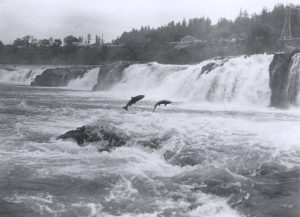Salmon make a very dangerous run up streams during their migration to their spawning grounds. The salmon migration, also known as the salmon run, is a time period when salmon migrate from the ocean to northern rivers. Most salmon migrate during the months of September through November. The more mild months are more relaxing for the fish while on the run. But the ocean is still the salmons home
After many years in the wide ocean, the salmon make their journey back to the exact spot where they were spawned. While on their journey from the pacific ocean to the northern Alaskan streams, they have to avoid many obstacles. From strong currents, bears, bald eagles, and fishermen, the salmon have to overcome the dangers of the run to return to their spawning grounds. Once the breeding grounds are reached, the female salmon start to build a nest called a Redd. Made in a riffle out of just gravel. A female salmon can make as many as 7 Redd’s before her supply of eggs runs out. Dominant male salmon guard the nests by chasing intruders out of their territory. They only do this once a lifetime, though.
Salmon are semelparous animals, meaning they only spawn once in a lifetime. The fish then quickly deteriorate and die. Not being able to adapt to the freshwater after being in the saltwater ocean for so long. Amazing that they are born in freshwater, but then travel to saltwater.
Could salmon ever adapt to freshwater after spawning?
What animal catches and kills the most salmon while on the salmon run?
Why do salmon spawn in freshwater if they live in saltwater for most of their lives?
